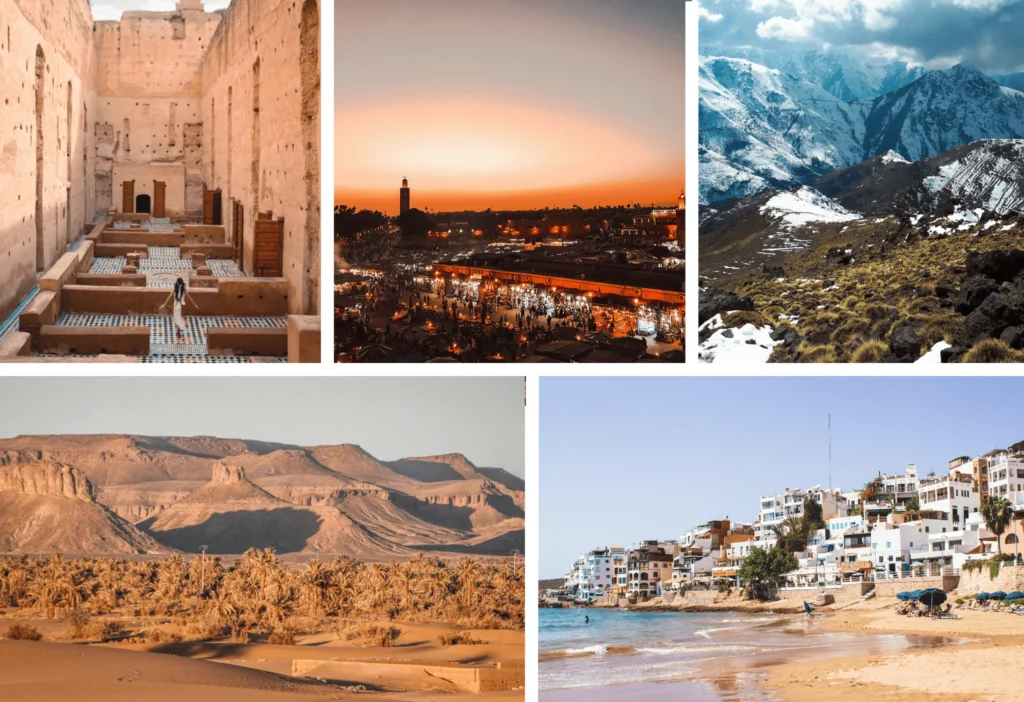
Best Things to Do in Morocco by Aniss AG– been surfing Morocco’s coasts and guiding travelers for 10+ years
Look, I’ve seen enough Morocco travel guides that make this place sound like some magical fairy tale where everything’s Instagram-perfect and the locals are always smiling. That’s not Morocco. That’s tourism marketing.
Morocco is wild, chaotic, beautiful, frustrating, and absolutely worth it – but only if you know what you’re walking into. I’ve lived here my whole life, spent years chasing waves from Dakhla to Tangier, and guided everyone from backpackers to billionaires through these ancient streets. Here’s what actually happens when you visit Morocco, not what the glossy brochures tell you.
What You’re Really Getting Into
First things first – Morocco will mess with your head. One minute you’re watching the most incredible sunset over Sahara dunes, the next you’re arguing with a guy who’s following you around Fez medina demanding money for “directions” you never asked for. It’s not personal. It’s just Morocco.
I’m going to give you 21 experiences that actually matter here, plus the real talk you need to handle them. Some of these will blow your mind. Others might make you want to book the first flight home. Both reactions are completely normal.
Table of Content
Here
- Get Lost in Marrakech’s Medina (But Know How to Get Found)
- Sleep in the Sahara (The Version Nobody Talks About)
- Trek the Atlas Mountains (Where Tourists Become Hikers)
- Master the Hammam (Or Let It Master You)
- Explore Casablanca (Morocco’s Most Underrated City)
- Surf Morocco’s Atlantic Coast (My Actual Job)
- Find Your Zen in Chefchaouen
- Survive Fez (Seriously, It’s Survival)
- Shop Like a Local in Marrakech
- Go Hollywood in Ouarzazate
- Cool Off in Paradise Valley
- Experience Real Berber Culture
- Follow the Writers in Tangier
- Explore the Imperial Cities (Rabat, Meknes, Volubilis)
- Get Your Music Fix (Morocco’s Biggest Festivals)
- Road Trip the Wild Atlantic Coast
- Eat Street Food (Without Getting Sick)
- See Goats in Trees (Yes, It’s Real)
- Experience Gnaoua Ceremonies
- Join Morocco’s Surf Revolution
- Talk to Locals (The Most Important One)
- My Realistic 7-Day Morocco Route (Itinerary That Works)
- FAQs (Everything You’re Wondering)
- Related Reading & Resources
1. Get Lost in Marrakech’s Medina (But Know How to Get Found)
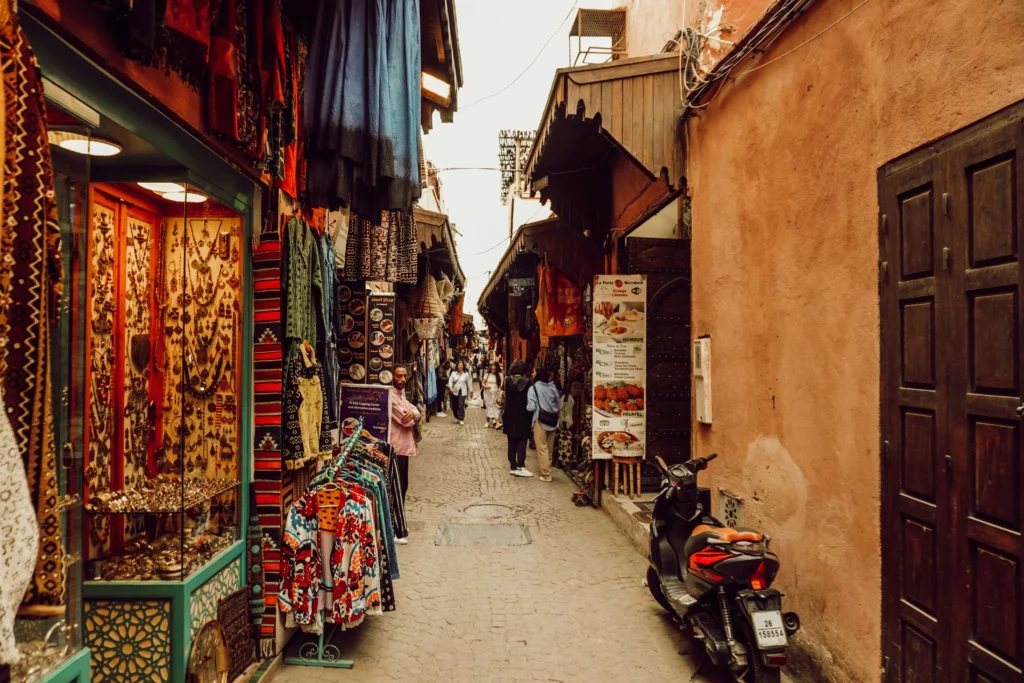
The Reality Check: Djemaa El Fna is genuinely magical around sunset – storytellers, musicians, snake charmers doing their ancient thing. It’s also ground zero for every scam artist in Morocco.
Here’s how we locals navigate it:
- The Koutoubia minaret is your North Star. All paths lead back to the main square eventually
- Orange juice costs 5 dirhams, not 20. If they say 20, laugh and walk away
- When someone puts a snake on your shoulders for photos, just hand it back and keep moving. Don’t argue, don’t negotiate, just move
My Favorite Time: Hit the medina around 8 AM. It’s a completely different place – quiet, authentic, just people going about their actual lives.
Hidden Spot: Skip the tourist riads and check out the Saadian Tombs right when they open at 9 AM. You’ll have the place mostly to yourself.
The souks are overwhelming by design. Leather workers, metalworkers, carpet sellers – they’re all masters at reading tourists. Start your bargaining at maybe 30% of their first price and be ready to walk away. Seriously, walking away works better than any negotiation tactic.
2. Sleep in the Sahara (The Version Nobody Talks About)
Everyone tells you the Sahara is life-changing. They’re right, but not for the reasons you think.
Erg Chebbi vs Erg Chigaga – Here’s the Real Difference:
Erg Chebbi (Merzouga) is easier to reach, has bigger dunes, better camps, and about 500 other tourists taking the same sunset photos you are.
Erg Chigaga requires a longer drive through absolutely nothing, has smaller dunes, and maybe 20 people total on a busy night. Guess which one I prefer?
About Those Camel Rides: They hurt. A lot. After 2 hours, you’ll understand why 4WD transfers exist. The Instagram shot isn’t worth the pain for most people.
Desert Camps Reality Check:
- Budget camps (30-50 EUR): Basic tents, shared bathrooms, authentic experience, questionable food
- Luxury camps (150-300 EUR): Hotel comfort in the middle of nowhere, incredible food, but you’re basically camping in a hotel
The stars are insane though. On clear nights, you can see the Milky Way with your naked eyes. That part lives up to the hype.
Timing: October through April. Trust me on this. I’ve seen tourists in July who looked like they were melting.
3. Trek the Atlas Mountains (Where Tourists Become Hikers)
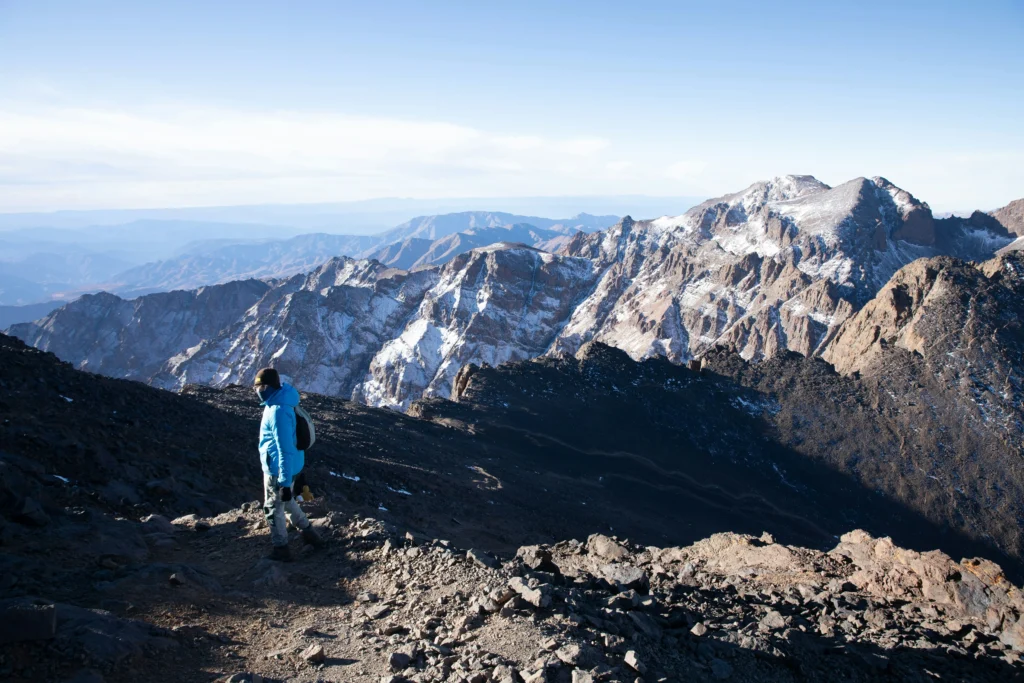
Mount Toubkal (4,167m) – North Africa’s highest peak. It’s not technical climbing, but it will humble you if you’re not in shape. Two days minimum: sleep at the refuge, summit attempt the next day.
Do you need a guide? Technically no. Should you get one? Yes, especially for cultural context. Good guides run about 40-60 EUR per day and they’ll teach you more about Berber culture than any guidebook.
Ourika Valley is the perfect Atlas introduction – 90 minutes from Marrakech, beautiful waterfalls, and actual Berber families who’ll invite you for mint tea if you’re respectful about it.
Pro tip: Don’t expect to summit Toubkal between November and April unless you know what you’re doing with snow and ice. I’ve rescued too many unprepared tourists from bad weather up there.
4. Master the Hammam (Or Let It Master You)
Hammams are not spas. They’re social institutions that have been running the same way for centuries.
Public hammams (3-8 EUR): Authentic, intimidating for first-timers, and absolutely worth experiencing if you can handle being the only tourist.
Hotel hammams (25-80 EUR): Comfortable, guided, and perfectly fine if you want the experience without the cultural immersion.
The process is always the same: steam, scrub with black soap and a rough mitt called a kessa, more steam, cold rinse, mint tea. You’ll leave feeling like you shed a layer of skin – because you literally did.
Buy your supplies at the souk: kessa mitt, savon beldi (black soap), ghassoul clay. Don’t buy them at your hotel unless you like paying tourist prices.
5. Explore Casablanca (Morocco’s Most Underrated City)
Everyone skips Casa for Marrakech. Their mistake.
Hassan II Mosque is genuinely one of the most impressive buildings I’ve ever seen, and I’ve seen a lot of mosques. 25,000 people can pray inside, 80,000 more in the courtyards. Non-Muslims can tour it – rare for major mosques.
The real gem is downtown Casa’s Art Deco architecture. During the French Protectorate (1912-1956), they built an entire city in Art Deco style. It’s like Miami Beach but with Moroccan details.
Zaha Hadid’s Grand Theatre is the new architectural showpiece – love it or hate it, you can’t ignore it.
6. Surf Morocco’s Atlantic Coast (My Actual Job)
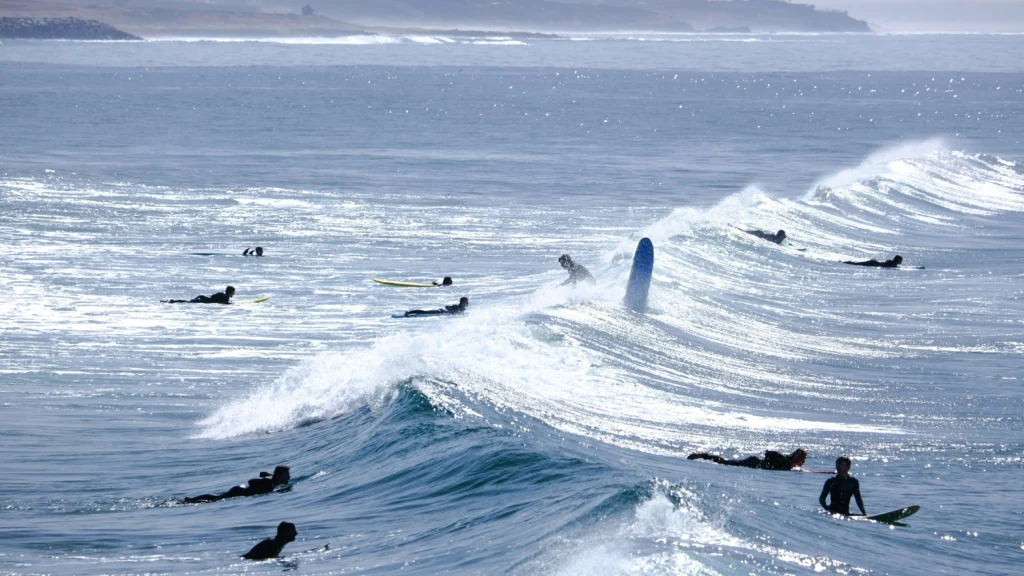
I’ve been surfing these coasts for over a decade, so here’s the real breakdown:
Essaouira: Windy as hell, perfect for kitesurfing and windsurfing. Beginner-friendly surf schools, but the wind never stops. Ever.
Taghazout: Morocco’s surf capital for a reason. Anchor Point has world-class waves when it’s working. Hash Point is perfect for intermediates. La Source will humble experienced surfers.
Sidi Kaouki: 25km south of Essaouira, fewer crowds, more consistent waves, and where I go when I want to surf without dealing with surf tourism.
Surf lessons run 25-35 EUR. Board rental is 15-20 EUR per day. The water’s cold – you’ll need a wetsuit pretty much year-round.
Best surf: October through April. Summer waves are smaller but the water’s warmer.
7. Find Your Zen in Chefchaouen
The blue city lives up to the hype, but not for Instagram reasons. It’s genuinely peaceful in a way other Moroccan cities aren’t.
Why is everything blue? Depends who you ask. Jewish refugees in 1492, mosquito deterrent, cooling effect, or just tradition. Pick your favorite theory.
Best photo time: Early morning (8-10 AM) when the light’s soft and there are fewer phone photographers blocking every doorway.
Beyond the blue walls: Hike to Akchour Waterfalls (2 hours moderate), swim in natural pools, continue to God’s Bridge if you’re feeling ambitious. It’s stunning and completely different from the medina experience.
8. Survive Fez (Seriously, It’s Survival)
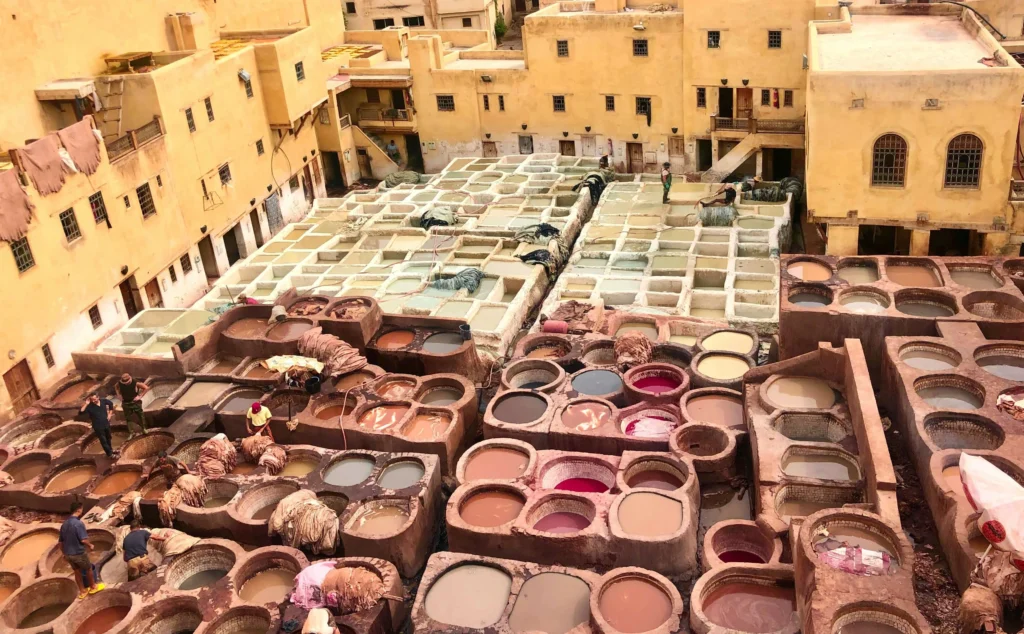
Fez is Morocco’s cultural capital and my least favorite city to visit. Amazing history, incredible architecture, and the most aggressive street harassment I’ve encountered anywhere in Morocco.
Fez El Bali: 9,000+ alleyways, 1,500 dead ends, and pickpockets who know exactly which tourists look lost. Hire an official guide for your first day (150 MAD) or prepare to get thoroughly confused and possibly harassed.
Chouara Tannery: 1,000 years old, still using pigeon droppings to soften leather, smells exactly like you’d expect. The mint leaves they give you actually help.
Real talk: I’ve been followed, sworn at, and had people demand money for “help” I never asked for in Fez more than anywhere else in Morocco. Stay alert, stay confident, and don’t be afraid to be rude if someone’s bothering you.
9. Shop Like a Local in Marrakech
The souks are organized by craft – metalworkers here, leather there, textiles over there. Learn the layout and you can comparison shop properly.
Bargaining reality: Their first price is usually 3-5 times what they’ll actually take. Start at 25-30% of their opening offer. Walk away if they won’t budge – you’ll be surprised how often they call you back.
What to buy:
- Berber carpets: Real ones are expensive (200-2,000 EUR). Get a certificate of authenticity.
- Argan oil: 15-25 EUR per liter for the real stuff. Cheaper = probably fake.
- Leather goods: Fez leather is the best quality. Marrakech has more variety.
Skip the haggling: 33 Rue Majorelle and the shops in Gueliz have fixed prices on quality stuff.
10. Go Hollywood in Ouarzazate
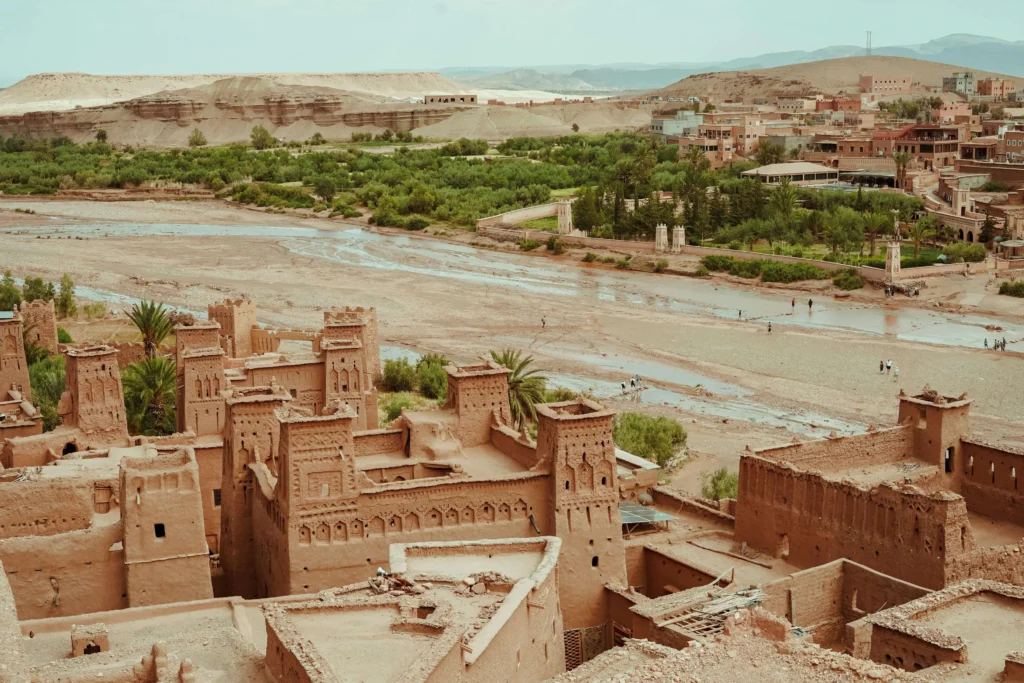
Morocco’s film capital. Atlas Studios is where they shot Gladiator, Game of Thrones, Lawrence of Arabia, and about 100 other movies you’ve seen.
Studio tours (7-10 EUR) are actually pretty cool – you get to see active sets and learn how they make the Sahara look like ancient Rome.
Aït Benhaddou nearby is the famous ksar you’ve seen in every desert movie. It’s a UNESCO site for good reason – 11th-century mud-brick architecture that looks like it grew out of the earth.
The climb to the top takes about 20 minutes and the views are incredible, especially at sunset.
11. Cool Off in Paradise Valley
An hour from Agadir, Paradise Valley is a series of natural pools and waterfalls carved into the Atlas foothills. Crystal clear water, palm trees, dramatic cliffs – it’s Instagram-worthy but genuinely beautiful.
The hike to the best pools takes about an hour. Bring swimwear and be ready to scramble over rocks. Tourist groups usually stop at the first pools, so keep hiking for the good stuff.
Day tours from Agadir run 16-25 EUR. Worth it if you don’t have a car.
12. Experience Real Berber Culture
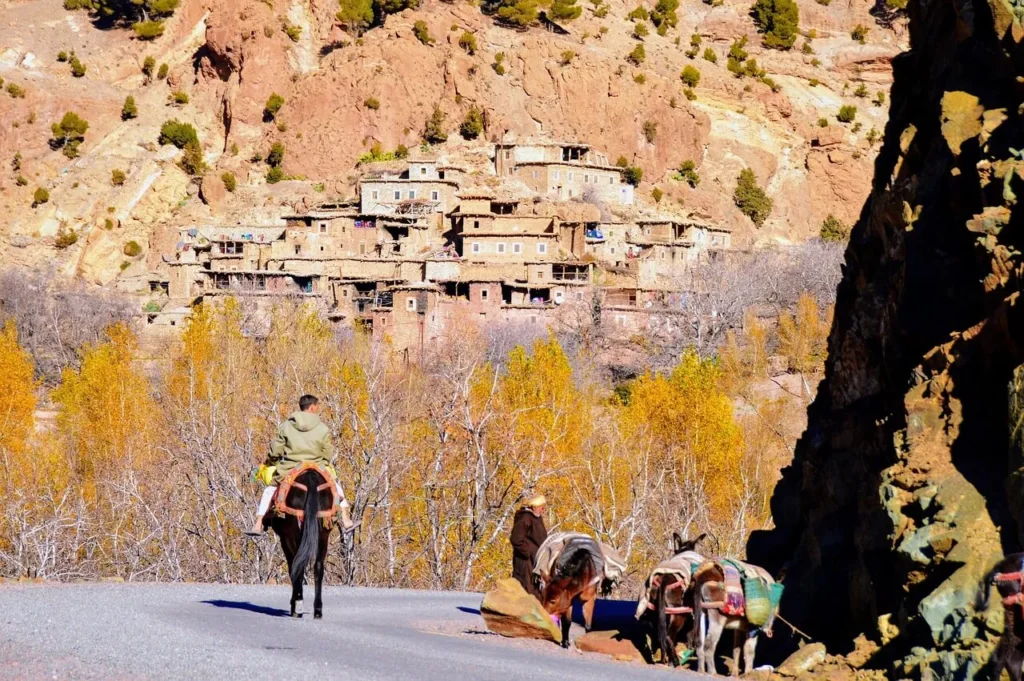
The Anti-Atlas around Tafraoute is where traditional Berber culture is still alive and functioning, not just performing for tourists.
Tafraoute’s Wednesday souk is the real deal – Berber families from mountain villages coming to trade, socialize, and do business. No tourist show, just life happening.
The villages in Ameln Valley still use traditional architecture, traditional farming, and many people speak Tamazight (Berber language) as their first language.
Argan cooperatives here are women-only operations processing argan nuts the same way they have for centuries. Buy direct and you know it’s authentic.
13. Follow the Writers in Tangier
Tangier was an international zone for decades, attracting writers and artists who couldn’t live freely anywhere else.
Hotel El-Muniria still has Burroughs’ room where he wrote “Naked Lunch.” The rooftop terrace overlooks the Mediterranean.
Café Hafa is where Paul Bowles, Allen Ginsberg, and Jack Kerouac used to hang out. Still serves mint tea, still has incredible views over the Strait of Gibraltar.
Librairie des Colonnes has been selling books since 1949 and was the unofficial headquarters for Tangier’s expat writer community.
The literary walking tours are actually good here – the guides know their stuff and the stories are true.
14. Explore the Imperial Cities
Rabat: Morocco’s actual capital, way more relaxed than Marrakech. Hassan Tower is impressive, the Kasbah of the Udayas has great sunset views, and you can walk around without being hassled every five minutes.
Meknes: Bab Mansour is probably Morocco’s most beautiful gate. The royal stables once housed 12,000 horses – the ruins are still massive.
Volubilis: Roman ruins near Meknes with incredible mosaics. Best preserved Roman site in Morocco and not crowded like European ruins.
15. Get Your Music Fix
Gnaoua Festival in Essaouira (June): Four days of spiritual music from descendants of sub-Saharan enslaved people. Free concerts throughout the medina, on the beach, everywhere. It’s magical.
Mawazine in Rabat: Huge music festival with international headliners. 2.5 million people attend annually.
Festival of Sacred Music in Fez: Sufi chanters, gospel singers, Buddhist monks – spiritual music from around the world in ancient venues.
Book accommodation early for festivals. Prices jump and places fill up fast.
16. Road Trip the Wild Coast
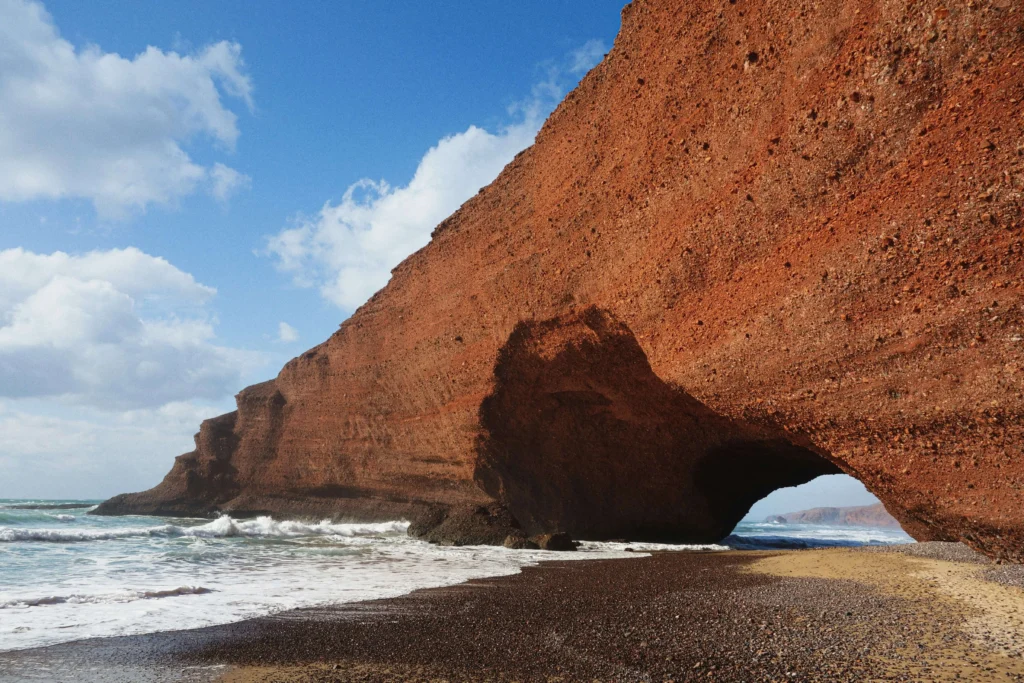
The drive from Agadir to Sidi Ifni is spectacular – wild beaches, red cliffs, fishing villages that haven’t changed in decades.
Legzira Beach: Famous for its natural arches. One collapsed in 2016 but the remaining one is still incredible.
Mirleft: Quiet surf town with great beaches and zero tourism infrastructure. Exactly how I like it.
You’ll need a car for this trip. Public transport to these places is limited and unreliable.
17. Eat Street Food (Without Getting Sick)
Marrakech: Grilled meat skewers (15-25 MAD), fresh orange juice (5-10 MAD), avoid the snail soup unless you’re feeling adventurous.
Essaouira: Best seafood in Morocco. Fish sandwiches from beach vendors are incredible and cheap.
Fez: Snail soup, fried eggplant, chebakia (sesame cookies) during Ramadan.
Safety rules: Hot food from busy stalls only. High turnover means fresh food. Avoid pre-cut fruit and raw vegetables in tourist areas.
18. See Goats in Trees (It’s Actually Real)
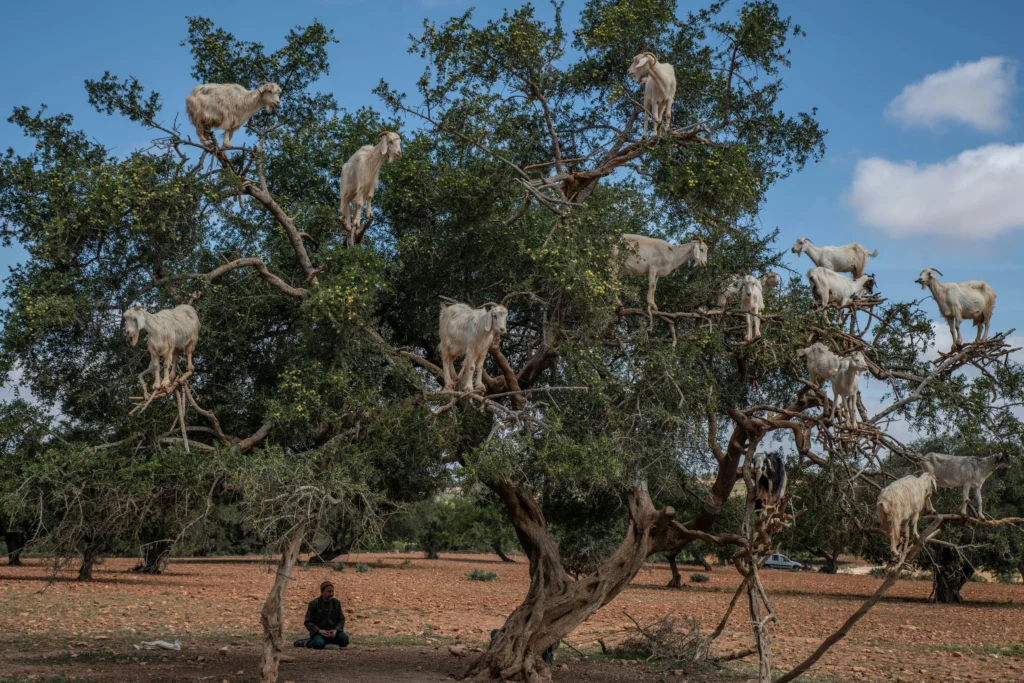
Between Agadir and Essaouira, goats really do climb argan trees to eat the nuts. Some roadside displays are staged for tourists, but it happens naturally all the time.
The argan oil cooperatives here are the real deal – women cracking nuts by hand, pressing oil using traditional methods. Real argan oil costs 15-25 EUR per liter and smells nutty.
19. Experience Gnaoua Ceremonies
Beyond the Essaouira festival, gnaoua music is spiritual healing tradition you can experience year-round in Marrakech and Essaouira.
It’s not entertainment – it’s ritual combining music, dance, and healing using traditional instruments like the karkaba and sintir.
Ask locals about ceremonies. They happen regularly but aren’t advertised to tourists.
20. Join Morocco’s Surf Revolution
Morocco’s surf scene is exploding. Young Moroccans are learning to surf, women are breaking cultural barriers to get in the water, and local board shapers are creating unique designs for our waves.
The bicultural surf communities in places like Taghazout are fascinating – traditional fishing families mixing with international surfers creating something completely new.
21. Talk to Locals (The Most Important One)
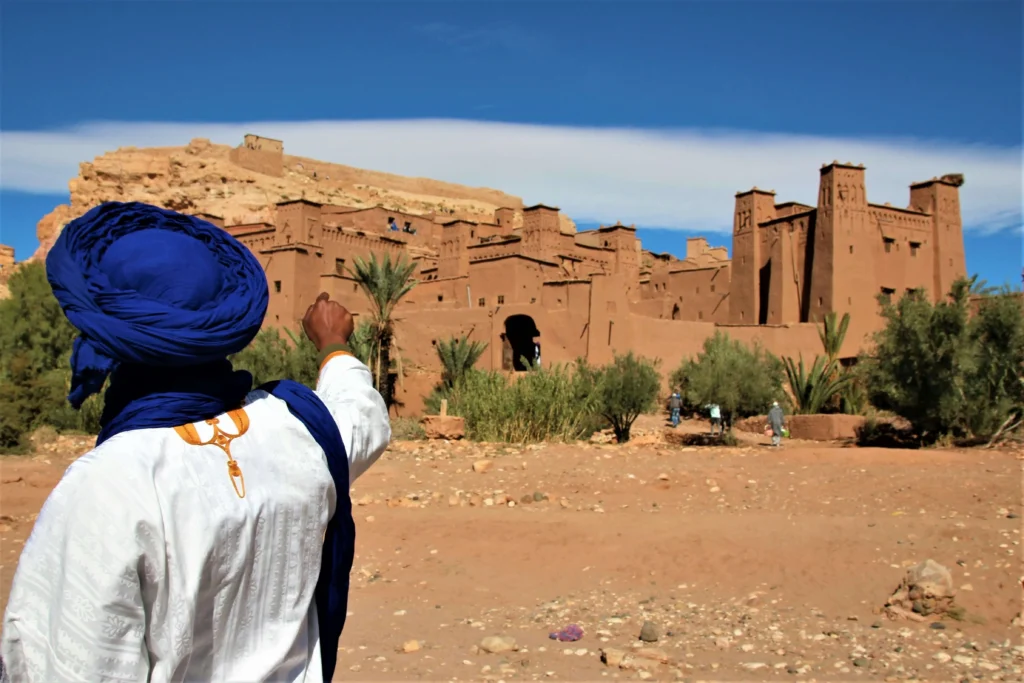
The best Morocco experiences happen through conversations with locals. Ask fishermen about their catch, shepherds about their goats, riad owners about their families.
Learn a few Arabic phrases – even basic greetings open doors. Most Moroccans appreciate the effort and will go out of their way to help respectful visitors.
Some people won’t want to chat with tourists – respect that. But many do, and those conversations become the stories you tell for years.
My Realistic 7-Day Morocco Route (Based on What Actually Works)
Look, most itineraries are written by people who’ve never dealt with Moroccan traffic, unrealistic travel times, or the fact that you’ll be exhausted after your first day in Marrakech medina. Here’s what I recommend to people who ask me personally:
Day 1 – Survive Marrakech
Land in Marrakech, find your riad (good luck with the address system), take a nap. Seriously, take a nap. Then walk around the medina for maybe an hour max. End up at Djemaa El Fna for sunset but don’t expect to love it immediately – it’s overwhelming. Eat something simple, go to bed early.
Day 2 – Actually See Marrakech
Morning: Hit Bahia Palace before the tour buses arrive (around 9 AM). Saadian Tombs if you’re into history. Afternoon: Either do a proper medina tour with a guide or escape to Ourika Valley. Don’t try to do both – you’ll be miserable. Evening: Maybe a hammam if you’re not too tired.
Day 3 – Coast Time
Drive to Essaouira. It takes 3 hours but feels longer. Check into your accommodation, walk the ramparts, maybe try to surf if the waves aren’t too big. The medina here is way more chill than Marrakech.
Day 4 – Actually Enjoy the Coast
Either stay in Essaouira and really explore it, or drive down to Taghazout (another 4-5 hours). If you choose Taghazout, you’ll be tired when you arrive. Surf lesson the next day, not today.
Day 5 – Beach/Surf Day
If you’re in Taghazout: surf lesson, beach time, maybe check out Paradise Valley if someone can drive you. If you stayed in Essaouira: explore the surrounding areas, try kitesurfing, or just relax.
Day 6 – Head Back (The Long Day)
Drive back toward Marrakech. If you want to see Ait Benhaddou, add 2-3 hours to your trip and prepare to be exhausted. It’s beautiful but might not be worth it if you’re tired. Otherwise, straight back to Marrakech.
Day 7 – Recovery and Shopping
Last-minute shopping in the medina (now that you know how it works), maybe a nice lunch, airport transfer. Don’t plan anything too ambitious.
Want Desert Instead of Coast?
Skip the Essaouira/Taghazout days entirely. Do Day 1-2 in Marrakech, then 2-3 days for a proper desert trip (Ouarzazate → Merzouga → back to Marrakech). Don’t try to do coast AND desert in a week unless you like spending more time in cars than actually seeing places.
Morocco Travel FAQs
Is Morocco safe for tourists?
Generally yes, but like anywhere, you need street smarts. I’ve lived here my whole life – Morocco isn’t dangerous, but it can be overwhelming, especially in tourist areas. Tourist police are everywhere in major cities. The biggest “dangers” are pickpockets and scam artists, not violent crime. Stay alert in crowded medinas and don’t flash expensive gear.
Is Morocco safe for solo female travelers?
This gets asked constantly. Reality check: Morocco is doable for solo women but it’s not easy. You’ll get more attention than male travelers, especially in tourist areas. Dress conservatively (shoulders and knees covered), stay confident, and don’t be afraid to be rude if someone’s bothering you. Many women travel solo here successfully – just be prepared.
What language do they speak in Morocco?
Arabic (Darija dialect) and Berber (Tamazight) are the main languages. French is widely spoken because of the colonial history. English is common in tourist areas but gets sparse once you leave the main cities. Learn a few basic Arabic phrases – locals really appreciate the effort.
Do you need a visa for Morocco?
Depends where you’re from. Americans, Canadians, Europeans, Australians get 90 days visa-free. Others need to check. Your passport needs to be valid for at least 6 months from entry date.
What’s the best time to visit Morocco?
March-May and September-November are perfect. Summer (June-August) is brutal inland – I’m talking 45°C/113°F in Marrakech and the desert. Great for the coast though. Winter can be cold in the mountains and desert nights, but perfect for Sahara trips.
How much should I budget for Morocco?
Huge range depending on your style:
- Backpacker: 25-40 EUR/day (hostels, street food, local buses)
- Mid-range: 60-100 EUR/day (riads, restaurant meals, guided tours)
- Luxury: 150+ EUR/day (high-end riads, private guides, fine dining)
Can you drink alcohol in Morocco?
Yes, but it’s complicated. Morocco is 99% Muslim so alcohol isn’t part of daily culture. You’ll find beer and wine in tourist restaurants, hotels, and some shops. Don’t drink on the street or bring alcohol into rural/conservative areas. Respect local customs.
What should I wear in Morocco?
Dress modestly. This isn’t just tourist advice – it’s respect. Cover shoulders and knees, especially outside tourist areas. Morocco is conservative, even in cities. Shorts and tank tops will get you stares and potentially hassled. Beach areas are more relaxed.
Is Morocco expensive?
Not compared to Europe/North America, but tourist prices vs. local prices are wildly different. A taxi ride that costs a local 10 dirhams might cost you 50 dirhams. Bargaining is essential in souks. Fixed-price restaurants and shops are usually fair.
How do you get around Morocco?
- Trains: Excellent between major cities. The Al Boraq high-speed train (Casablanca-Tangier) is impressive. Buses: CTM and Supratours are reliable for longer distances. Cheap but slow. Taxis: Petit taxis within cities (use the meter), grand taxis between towns. Car rental: Great for rural areas, nightmare in cities.
Can you surf in Morocco as a beginner?
Absolutely. Morocco has perfect beginner waves and great surf schools, especially around Essaouira and Taghazout. Water’s cold year-round (wetsuit needed), but waves are consistent. Surf lessons cost 25-35 EUR including gear.
What’s the deal with tipping in Morocco?
Tipping culture is strong here. Restaurant servers expect 10-15%, hotel staff appreciate small tips, guides expect tips (10-20 EUR per day), taxi drivers appreciate rounding up. Small bills (5-20 dirham notes) are essential.
Do I need vaccinations for Morocco?
No required vaccinations, but hepatitis A/B and typhoid are recommended. Check with your doctor. Drink bottled water and be careful with street food if you have a sensitive stomach.
Can you use credit cards in Morocco?
In cities and tourist areas, yes. Rural areas and small shops are cash-only. ATMs are everywhere in cities but can be sparse in small towns. Bring euros or dollars to exchange – better rates than using cards everywhere.
What about internet and phone service?
WiFi is common in hotels, riads, and cafés in cities. Phone coverage is good except in remote mountain/desert areas. Buy a local SIM card if you need data – much cheaper than international roaming.
Is haggling really necessary?
In souks and with street vendors, absolutely. It’s expected, not optional. Start at 25-30% of their opening price. In restaurants with menus and modern shops, prices are usually fixed.
What’s the best way to see the Sahara Desert?
Book through reputable operators in Marrakech or Fez. 2-3 day trips work best (day 1: travel, day 2: desert experience, day 3: return). Erg Chebbi (near Merzouga) is more accessible, Erg Chigaga is more remote. Expect to pay 120-180 EUR per person for a proper desert experience.
Can you visit Morocco during Ramadan?
Yes, but it’s different. Many restaurants close during daylight hours, things run slower, and you should be extra respectful about eating/drinking in public. The evening iftar (breaking fast) celebrations are incredible to witness though.
What souvenirs should I buy in Morocco?
Worth buying: Argan oil (15-25 EUR/liter for authentic), Berber carpets (get certificates), leather goods from Fez, traditional ceramics, spices. Skip: Cheap “Moroccan” goods made in China, overpriced tourist versions of everything.
How safe is the food in Morocco?
Street food is generally safe if you follow basic rules: hot food from busy stalls, avoid pre-cut fruit, drink bottled water. Moroccan cuisine is incredible – don’t let food fears stop you from trying it. Start with simple dishes if you have a sensitive stomach.
Related Reading & Resources
My Other Morocco Guides:
- Best Time to Visit Morocco: Month-by-Month Local Weather Guide – Detailed seasonal breakdown with what to expect each month
- Morocco Surf Guide: Best Spots for Every Level – Complete guide to Morocco’s surf breaks from a local surfer’s perspective
- How to Travel Morocco on a Budget Without Missing the Magic – Practical tips for backpackers and budget travelers
- Surfing in Morocco for Beginners: A Local’s Ultimate Guide – Honest advice and safety tips
Recommended Travel Resources:
- Lonely Planet Morocco – Still the most comprehensive guidebook for Morocco
- Nomadic Matt’s Morocco Guide – Budget travel perspective
- The Culture Trip Morocco – Cultural insights and contemporary Morocco
Cultural & Historical Context:
- The Voices of Marrakech by Elias Canetti – Classic travel literature about Morocco
- The Caliph’s House by Tahir Shah – Expat experience living in Morocco
- Morocco That Was by Walter Harris – Historical perspective on traditional Morocco
- Understanding Islam in Morocco – Religious and cultural context
- Berber Culture and History Guide – Indigenous culture of North Africa
Booking & Accommodation:
- Booking.com Morocco – Wide selection of riads and hotels
- Hostelworld Morocco – Budget accommodation options
The Bottom Line
Morocco isn’t easy. It’s not relaxing. It won’t be like anything you’ve experienced before.
But it’s real. The culture is alive, not preserved in museums. The landscapes are dramatic. The people – when you connect with them properly – are incredibly welcoming.
Come prepared for chaos, bring patience, respect local customs, and expect to be changed by the experience. Morocco doesn’t just show you different places – it shows you different ways of being in the world.
Pack light, bring an open mind, and prepare for the adventure of a lifetime. Just don’t expect it to be easy.
Want more insider Morocco content? Follow my adventures at YourWebsite.com and connect with me on Instagram @aniss_morocco for daily Morocco updates.
